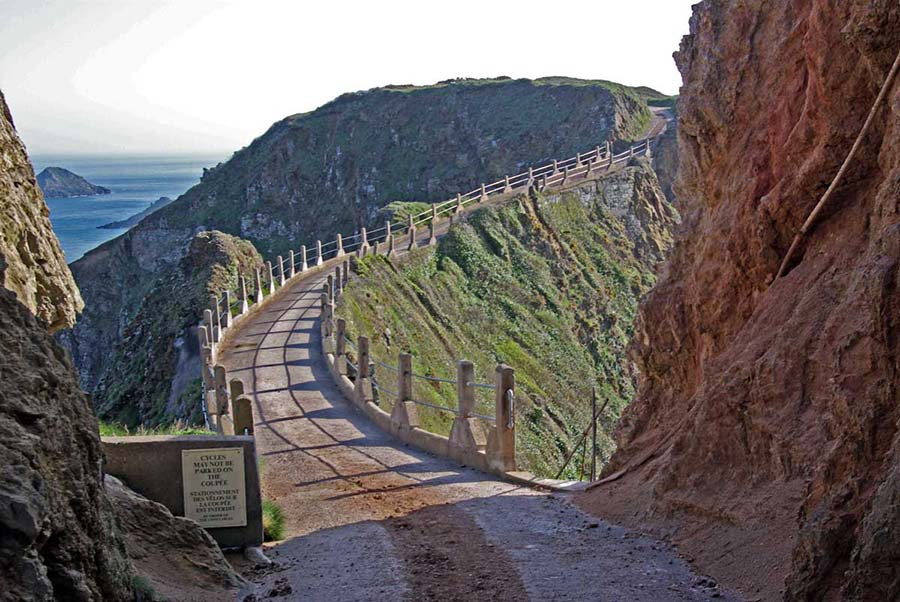Sark

One of the smaller islands within the Bailiwick of Guernsey, Sark totals two square miles and has a population of around 600. Although everyone speaks English, it has its own language, Sercquiais, which is descended from Norman.
Sark is nine miles from Guernsey and almost — but not quite — attached to the neighbouring island of Brecqhou.
Remus Carey knows Sark well as it is surrounded by fertile fishing grounds that are also good for lobster, and the fact that his boat, the Huffin’ Puffin was found close to the island after Remus disappeared is the only clue that his son, Ollie, has to go on when he is trying to find out what happened to him.
The island is split into two parts. The smaller part is consistently called Little Sark, but various maps call the larger part Big Sark, Greater Sark or Great Sark. The official States map produced by the government of Guernsey, simply labels the larger part as Sark. The two parts are joined by La Coupee (see below), a narrow path around 350ft high, with steep sides that lead down to one of the best beaches on the island.

There are no cars on the island, so transport is mainly bike, foot or horse, although some residents run tractors. There is optional tractor transport up from the harbour, and the island ambulance is towed by a tractor. This proved an issue for Charlie Dubois when sent to the island in book 1, Dead in the Water, and in need of a quick route back:
He was running along Sark’s only real street. On an island without any cars, it was that or a bike or a horse, and he didn’t have time to scout round for either. Neither was he sure when the next scheduled boat would be leaving. If it came to it, he’d assured Renouf, he’d bribe a trawler to offload some pots and find him some space on its deck.
In his book, The Silent War, Frank Falla describes how the matter of vehicles on Sarks roads was a sensitive matter even during the German occupation. He writes,
…the censor’s blue pencil descended thick and heavy on a story I wrote in The Star about Sark. When I first heard the facts I phones Goettmann, told him what I knew and asked if I could go ahead. Back came the answer, ‘Certainly’. The paper’s final page proof carried the story but when it was finally submitted to Goettmann and ready for printing, the sark article — lock, stock and barrel — was deleted.
The whole undertone of the article may have caused the trouble; or the headlines, ‘Motor Cycles, Cars and a Lorry on Sark Roadways — Peace of Small Island Shattered’ may have been too forthright. We printed about a hundred copies of the paper before receiving the deletion, so some people may still have copies of the banned article, with emphasis on the fact that Sark’s ban on all cars had been rudely broken.
The ban on cars is maintained to this day and not even visits from the Queen, Prince Philip or the Home Secretary would move Sark people to think of lifting the ban. When the high and mighty go to Sark they travel like other people (and they themselves would not have it otherwise) by horse-drawn carriage.
Law and governance
Despite the small population, Sark has its own Parliament and laws based on Normal law. The Parliament consists of 28 elected members, one life member and one hereditary member. Previously it comprised 40 tenant members, whose right to be there came down from the original 40 tenant families who were required by the Crown, owner of the island, to live on it and defend it.
The island was Europe’s last fiefdom until as late as 2008, overseen by the Seigneur (or Dame if the position was held by a woman) who would inherit it from their ancestors. The Seigneur (or Dame) appoints a Seneschal as the head of the Parliament and island judge.
Seigneurs and Dames of Sark
-
1500s
Hellier de Carteret1563 – 1578Came up with the idea of cultivating Sark — at the time a baren island — and granted the fiefdom by Queen Elizabeth I.
-
Philippe de Carteret I1578 – 1594
Married to Rachel Poulet, who was the daughter of the Bailiff of Jersey and daughter of the Governor of Jersey.
-
1600s
Philippe de Carteret II1594 – 1643Also Bailiff of Jersey. Knighted in 1617. Apparently highly fertile, he had 10 children — seven sons and three daughters.
-
Philippe de Carteret III1643 – 1663
Fought on the side of the king in the English Civil War and was subsequently knightered on At Aubin’s Bay beach in Jersey by Charles, Prince of Wales, while the latter was in exile.
-
Philippe de Carteret IV1663 – 1693
-
1700s
Charles de Carteret1693 – 1715 -
John Carteret1715 – 1720
Lord President of the Council in Britain from 1751 until 1763 during the Prime Ministership of Spencer Compton (effectively meaning he was running the country). He was the British ambassador to Sweden and also inherited an eighth of the Province of Carolina.
-
John Johnson1720 – 1723
Became Seigneur when he purchased the fiefdom from John Carteret.
-
James Milner1723 – 1730
Bought the fiefdom from John Johnson for £5000. Although his won would have taken it over on his death, the son was the Bishop of Gloucester, and he in turn sold it on without ever assuming the role.
-
Susanne le Pelley1730 – 1733
-
Nicolas le Pelley1733 – 1742
-
Daniel le Pelley1742 – 1752
-
Pierre le Pelley I1752 – 1778
-
1800s
Pierre le Pelley II1778 – 1820 -
Pierre le Pelley III1820 – 1839
-
Ernest le Pelley1839 – 1849
Mortgaged the fiefdom for £4000 to finance the continued operation of the island’s silver mine. However, the mine collapsed and was subsequently closed, so the seigneurie, the Seigneur’s feudal home, was sold for £6000 to meet the mortgage payments.
-
Pierre Carey le Pelley1849 – 1852
-
Marie Collings1852 – 1853
Collings is said to have never visited Sark during her term of office since she was too old to govern it effectively. She remained at home in Guernsey the whole time and was represented by her son on Sark, William Thomas Collings, who would become the next Seigneur.
-
William Thomas Collings1853 – 1882
A priest from Guernsey, Collings did much to develop the island, opening some small hotels to encourage tourism and funding churches and graveyards. He only spent his summers on Sark, returning to Guernsey for the winter. He funded a militia on the island.
-
1900s
William Frederick Collings1882 – 1927Allowed his father’s militia to disappear, was a keen sportsman and said to have been a violent alcoholic and an opponent of the authority of the clergy.
-
Sybil Hathaway1927 – 1974
The daughter of William Collings, Sybil was raised as thought she was a boy and despite her physical disability (one leg shorter than the other) was taught to shoot and climb cliffs. She moved to London and married Dudley Beaumont, grandfather of Michael Beaumont (see below), against her father’s wishes and she didn’t move back to Sark until after her mother’s death in 1912. Beaumont died of flu in 1918.
She inherited the fiefdom when her father died in 1927, introduced the ban on motor vehicles as a means of encouraging tourists, and met Robert Hathaway while on holiday in America in 1929. They married 12 days later and he technically became co-ruler of the island, although in practice it was Sybil who maintained control.
The German Occupation of the Channel Islands from 1940 until 1945 encompassed Sark. Hathaway spoke German and maintained cordial relations with the occupying forces despite making them bow before her before she allowed them to sit in her presence.
She died of a heart attack, at home, in 1974, aged 90.
-
Michael Beaumont1974 – present
As grandson of Sybil Hathaway, Michael Beaumont inherited the fiefdom on her death as his father had been killed during a Blitz raid in the Second World War.
French invasion
Each transition from one Seigneur or Dame to the next appears to have been undertaken without much fuss, but that might not have been the case if French nuclear physicist Andre Gardes had his way. He considered himself to be the rightful heir to the position and so he staged an unsuccessful ‘invasion’ in 1990. His downfall was most likely due to the fact that he had posted notices announcing his intention to invade the day before making his attempt, which was scheduled to take place at noon.
The Seigneur himself was off the island at the time, having travelled to Guernsey to collect a cheque but the local volunteer constable found the would-be invader sitting on a bench, loading his weapon. When the constable asked for a closer look, Gardes handed it over, at which point the constable arrested him.
Image and video credits
Sark in context
Sark in brief
One of the smaller islands, lying nine miles east south east of Guernsey, alongside the even smaller Brecqhou. Considered, until 2008, to be the last bastion of feudalism in Europe. Daily boat crossings from Guernsey take around 45 minutes.
Its main business is tourism, with many visitors being attracted by the quieter way of life. Cars are banned on the island, but some tractors are permitted.
See also...
Headland, with a tower, at the northern end of the island
Second largest Channel Island
Shallow sandy beach to the north
Common and bay at the north of the island
Long, deep bay in the south east of the island

FREE Guernsey newsletter
Don't miss our weekly update on Guernsey's fascinating history. We promise never to sell your data to anyone else, and there's a super-easy unsubscribe link on the bottom of each email so you can leave whenever you want.








